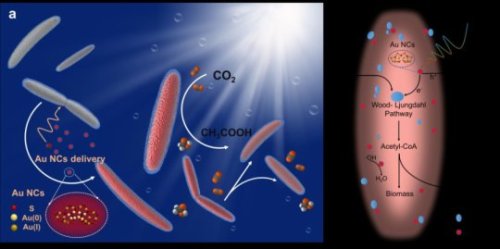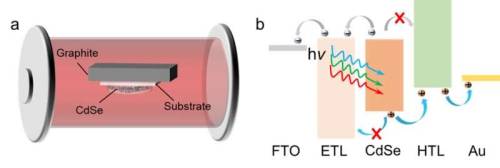#cadmium
This bacterium gets paid in gold
Harvesting solar fuels through a bacterium’s unusual appetite for gold
A bacterium named Moorella thermoacetica won’t work for free. But UC Berkeley researchers have figured out it has an appetite for gold. And in exchange for this special treat, the bacterium has revealed a more efficient path to producing solar fuels through artificial photosynthesis.
M. thermoacetica first made its debut as the first non-photosensitive bacterium to carry out artificial photosynthesis in a study led by Peidong Yang, a professor in UC Berkeley’s College of Chemistry. By attaching light-absorbing nanoparticles made of cadmium sulfide (CdS) to the bacterial membrane exterior, the researchers turned M. thermoacetica into a tiny photosynthesis machine, converting sunlight and carbon dioxide into useful chemicals.
Now Yang and his team of researchers have found a better way to entice this CO2-hungry bacterium into being even more productive. By placing light-absorbing gold nanoclusters inside the bacterium, they have created a biohybrid system that produces a higher yield of chemical products than previously demonstrated. The research, funded by the National Institutes of Health, was published on Oct. 1 in Nature Nanotechnology.
Post link
Periodic Videos on YouTube talks about some of the applications of the element cadmium, as well as showing a sample of the metal.
A key component in battery production, eighty six percent of cadmium produced is used in this particular application - primarily in the form of rechargeablenickel-cadmium batteries. A further six percent of production is used in electroplating, usually to help aircraft resist corrosion. Other uses of the element include as a barrier to control neutrons in nuclear fission, with helium as a blue-ultraviolet laser, and in various compounds as a semiconductor, the blue and green phosphors for color television picture tubes, a photoconductive surface coating for photocopier drums, and pigments.
Though not necessary for most forms of life, molecules containing cadmium have been found in some marine diatoms, taking the place of zinc in other organisms. Cadmium is an extremely toxic metal and the inhalation of fumes containing cadmium can lead to chemical pneumonitis, pulmonary edema, and death. The element is also considered an environmental hazard.
Rapid preparation of CdSe thin-film solar cells
The silicon-based tandem solar cell is regarded as the most promising strategy to break the theoretical efficiency limit of single-junction Si solar cells. With Si-based tandem solar cells as the bottom cells, the optimal bandgap of top cells is 1.7 eV, which enables high efficiency of ~45% for two-junction tandem solar cells. III-V semiconductors/Si and perovskites/Si tandem solar cells have achieved high efficiency levels of ~30%, proving their feasibility. However, the stability challenges of perovskite and the high-cost problem of III-V semiconductors largely limit their wide applications. Exploring new stable, low-cost, and bandgap 1.7 eV photovoltaic materials is of great significance in science and broad prospects in technology.
Cadmium selenide (CdSe), a binary II-VI semiconductor, enjoys great potential in the application of Si-based tandemsolar cells because of the suitable bandgap of ~1.7 eV, excellent optoelectronic properties, high stability, and low manufacturing cost. Nevertheless, the progress of CdSe thin-film solar cells remains as it was 30 years ago, and there are few systematic studies on CdSe thin-film solar cells in recent years.
Professor Tang Jiang and his team have proposed a method of rapid thermal evaporation (RTE) to obtain high-quality CdSe thin films and have designed CdSe thin-film solar cells. This study, entitled Rapid thermal evaporation for cadmium selenide thin-film solar cells, was published in Frontiers of Optoelectronics on Dec. 6, 2021.
Post link

Dot the eyes and cross the street



